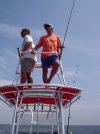MolarBoater
Contributing Member
- City
- Mountian Brook
Went to the Mobile seminar on March 8th and got to see and hear alot of good information from George Poveromo, Capt' Harry, Dr. Bob Ship and a few other guys, all which would be nice to have a beer with one day. They kept the focus on the fact that most of us fish from center consoles of 26' or less (trailerable boats) and the things we can do and places we can go.
Maybe the number one thing to help us be more productive fishing is to implement the tools which allow our baits whether live, dead, artificial or combo to be more noticed and enticing than the boat next to you. Outriggers, downriggers, chum, chuncking, surface comotion like teasers, looking for anything on the surface, in the air and to hone in your sounders by increasing the gain and magnifying the bottom 50% or wherever you are trying to fish other than the surface.
Most agreed that you need to have some "meat" on your hook whether live or dead or even Gulp for reef or inshore.
They went over so many things, species, techniques and such it would be hard to cover everything in a single post but I will focus on one subject at a time and post subsequent replies to this thread so that everyone can maybe pick up a pearl or two.
Will post info on trolling spreads, tuna, reef fishing, cobia, daytime swordfishing (just a little), trout and redfish, wahoo and anything else I made notes on....I took alot of notes!
Maybe the number one thing to help us be more productive fishing is to implement the tools which allow our baits whether live, dead, artificial or combo to be more noticed and enticing than the boat next to you. Outriggers, downriggers, chum, chuncking, surface comotion like teasers, looking for anything on the surface, in the air and to hone in your sounders by increasing the gain and magnifying the bottom 50% or wherever you are trying to fish other than the surface.
Most agreed that you need to have some "meat" on your hook whether live or dead or even Gulp for reef or inshore.
They went over so many things, species, techniques and such it would be hard to cover everything in a single post but I will focus on one subject at a time and post subsequent replies to this thread so that everyone can maybe pick up a pearl or two.
Will post info on trolling spreads, tuna, reef fishing, cobia, daytime swordfishing (just a little), trout and redfish, wahoo and anything else I made notes on....I took alot of notes!

